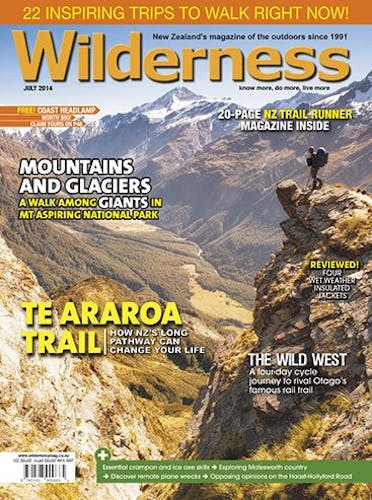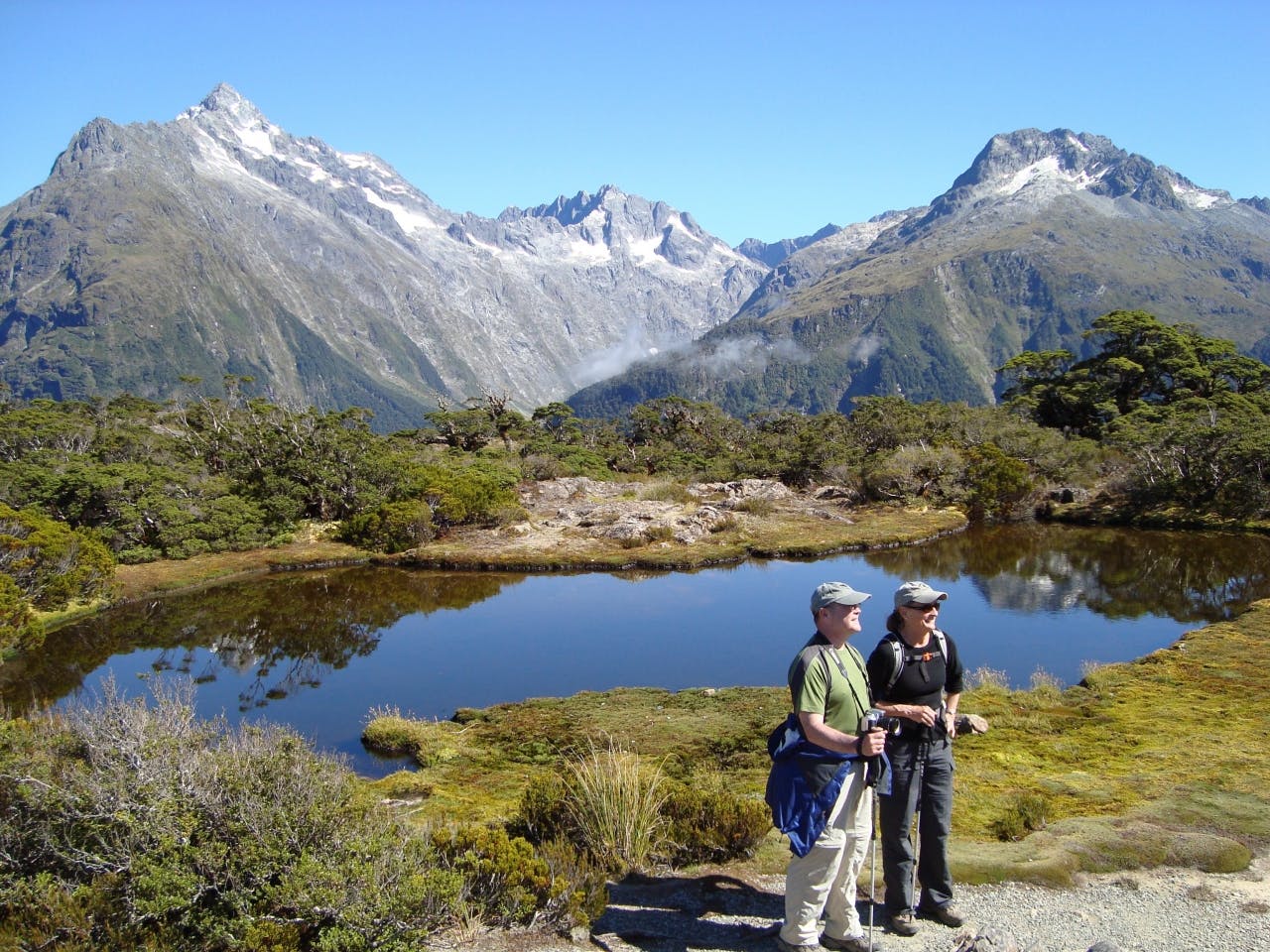Seeing the benefits of a wilderness unseen
A Haast-Hollyford road has long been a possibility lying dormant. To many people, its re-emergence represents an underlying and fundamental challenge to the value of a notional ‘wilderness’. Some of the arguments against a road through this area were outlined within two articles in the May issue of Wilderness. However, I wish to offer and test some further thoughts to support the argument against the road by advocating the value of retaining that ‘wilderness’ for the majority of us who will probably never even get to see or experience it.
Years ago, I read a book called Hidden Water, by Phillip Houghton (published in 1974), about the area and his life there. It finished with an impassioned plea against ever putting a road through the Hollyford. His words struck a chord with me:
‘Somewhere there has to be a halt. These wilder places of the earth must be preserved for men to wander in – with the minimum of machinery – for their refreshment, for their very health. Even in this unsophisticated country we have found it necessary to remind, from time to time, those governing in our name, that these things exist, and that their continued existence is at least as important as anything else.’
Houghton belongs to that small group of people who have spent (or who will spend) real time in the Hollyford area, living there, exploring, climbing, getting to know it intimately, in all its moods and weather. He communicated his love of the place and the precious value of it, as ‘wilderness’, available only to those who make the determined effort to experience it.
‘And let them cross no roads’ he wrote.
Essentially, it is an argument that, for that small group of fit, keen and capable outdoors people, their experiences are richer for the remoteness and absence of a road. These are sentiments that I relate to and support.
But isn’t this being rather exclusive, seeking to preserve such a large area for the benefit of only a small user-group?
That is an argument for supporters of the road. A road would certainly enable many more people to see, enjoy and in many ways benefit from this sublime natural landscape. Undoubtedly, this argument has the weighty strength of numbers and the appeal of democratic logic. It suggests a compromise on behalf of the privileged few. However, if this reasoning is expanded further, beyond just the potential users of the road and some regional business opportunities, then I think there is a case to make that we all, as a society – being a yet larger group – benefit far more from retaining wilderness areas, even if we personally never see them.
Although I am fit and confident enough to venture into the Hollyford area, I probably will not do so. Nevertheless, just knowing that this wilderness area is there is extremely important. Among other things, it provides me with an irrational sense of security. It affects the way I feel about living in this country and how I feel about ‘us’ as a people. These are personal benefits. However, I contend that society generally also gains such benefits from the preservation of wilderness areas (beyond the extensive economic values associated with supporting the ‘100% Pure’ brand and like marketing images). I am talking about such things as the relationship between our collective actions and self-belief, our cultural identity and pride.
These are some of the indirect benefits that come to us, as a society, in proving to ourselves that we can exercise the necessary restraint and self-control to keep our hands off this wilderness area; in not doing everything – just because we can.
It is like proving that we can drink without succumbing to alcoholism; that we have the maturity of the hunter who no longer needs to kill; that we have the restraint of the endurance athlete, who paces herself to victory. These are some of the qualities that we need to put into practice, as a society, in order to have any hope and optimism for our future, and to feel comfortable with ourselves.
In this respect, I see the road proposal heading in the wrong direction.
So, even if I never get to see this particular wilderness area, I am pleased for the people who have and will. I will be content just knowing it is there. I believe its preservation will reflect and help reinforce an evolving social maturity that is so necessary for our continued survival on this planet.
Yes, only relatively small numbers of people will really get to experience the remote Hollyford area. And fewer still will ever know it like Houghton, who described the place as being the ‘marrow’ of his existence.
But I for one would still prefer to hear or read their accounts of it, than see a barrage of snap-shots taken from the side of the road.
-Paul Quinlan is a landscape architect and outdoors enthusiast based in the Far North.
Environment and economy stand to benefit
As a Greymouth-based eco and scenic tour operator for the past 16 years, I am strongly in favour of building the Haast-Hollyford Rd and foresee its positive impacts on the West Coast, Southland and Otago economies.
The Wilderness article about the Haast-Hollyford Rd published in the May 2014 issue, opened with a double page photo of the Hollyford Valley, asking readers whether it would be acceptable for a private road to be built “through this valley in Fiordland National Park”.
The article failed to mention that there is already a road through the pictured valley, built in the 1930s: the 119km Milford Road. That’s more than 70 years without the oft-quoted negative consequences cited for the proposed Haast to Hollyford road, which would be built on only a few kilometres of the pictured valley and not at all in the area shown.
The use of the public estate for private benefit is an accepted component of New Zealand’s public land administration. DOC licences thousands of private enterprises on the conservation estate every year, charging a concession fee for the privilege. A prime example is the world-renowned Milford Track, only a valley or two away from the Hollyford, where Ultimate Hikes operates a guiding concession on the track for those wanting comfort and assistance.
Opponents to the road, like FMC president Robin McNeill, say the costings provided by Haast Hollyford Highway Ltd – $230million – are “vastly underestimated”. McNeill says the cost is more likely to be $1-$1.5billion. Unfortunately, neither party has offered a breakdown of costs, but the fact is, the developers will need to keep costs within a range that allows them to attain a financial return within the proposed 30-year ownership period.
While domestic tourists may find the suggested toll a deterrent to using the road, overseas visitors, used to charges for entering national parks in their own countries, will not baulk at $35 per person, nor in my opinion based on more than 30 years in the tourism industry, at $50 or more. People will happily pay where they see a clear benefit to themselves.
And let’s get this cost in perspective. Hundreds of people each day pay $70 for a scenic cruise on Milford Sound. Others pay $180 for a five-second free-fall off a perfectly good bridge with just a rubber band tied to their ankles. Considering the proposed road will save 355km in travel and allow the exploration of new landscapes, the projected toll fee looks minimal.
Environmentally, the road makes good sense. The huge saving in vehicle travel for both private cars and coaches is an undoubted plus, reducing carbon emissions and easing vehicle and visitor congestion at Milford Sound.
Contrary to Forest and Bird’s Kevin Hackwell, the road will be an asset in the fight against predators because it will allow easier access. Hackwell was quoted as saying the road will act as a conduit for invasive pests and weeds. This implies that legions of predators are waiting for the ribbon to be cut so they charge into a pristine environment. But the region is already infested with pests and predators – stoats, deer, rats, chamois. To preserve the true character and nature of New Zealand’s unique wilderness areas, we have to actively manage them for predator control and invasive weed species. Any infrastructure which enables this to happen has got to have long term benefits for the environment.
The conservation estate is useful to New Zealand if we have the ability to utilise its resources as well as protecting its features for their intrinsic, aesthetic and environmental values. Even as an ‘untouched’ World Heritage Area, we are exploiting its resources already, as witnessed by the number of tour operations and ventures that proudly proclaim their access to the area in which the Haast-Hollyford Rd is proposed.
Furthermore, images of Fiordland and South Westland are extensively used to promote New Zealand. It is all done for economic gain. This does not mean we can wantonly destroy it or cause irreparable harm to the natural environment. But we can utilise it to provide benefit to New Zealanders – the aesthetic pleasure of scenic viewing, the economic growth from increased visitor numbers to remote regional communities, the improved access for predator control and enhanced access for trampers. The granting of UN World Heritage status is not a ban on utilising the area – it is an injunction to ensure the values and features of the area are protected. Accessing them is still permissible.
In this day and age, the separation of environmental protection from economic activity is not a plausible concept; the two should be interconnected. When we isolate land, through protection in the conservation estate, we also allow governments to isolate and reduce funding for that land, as has recently happened with the reduction of funding to the Department of Conservation.
Where environmental protection and economic activity are inextricably linked in a relationship which benefits both, then future governments will be more cautious in reducing funding because of the economic benefits.
– Matthew Lysaght is co-owner of Kea Heritage Tours, based in Greymouth. For 16 years he and his wife, Linda, have operated eco tours throughout the West Coast and South Island.








